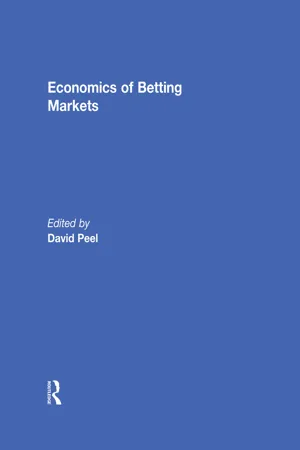![]()
Bounded cumulative prospect theory: some implications for gambling outcomes
Michael Caina, David Lawa and A.Peel Davidb
aSchool for Business and Regional Development, University of Wales, Bangor, Gwynedd LL57 2DJ, UK
bDepartment of Economics, Management School, University of Lancaster, Lancaster LA1 4YX, UK
Standard parametric specifications of Cumulative Prospect theory (CPT) can explain why agents bet on longshots at actuarially unfair odds. However, the standard specification of CPT cannot explain why people might bet on more favoured outcomes, where by construction the greatest volume of money is bet. This article outlines a parametric specification than can consistently explain gambling over all outcomes. In particular we assume that the value function is bounded from above and below and that the degree of loss aversion experienced by the agent is smaller for small-stake gambles (as a proportion of wealth) than usually assumed in CPT. There are a number of new implications of this specification. Boundedness of the value function in CPT implies that the indifference curve between expected-return and win-probability for a given stake will typically exhibit both an asymptote (implying rejection of an infinite gain bet) and a minimum, as the shape of the value function dominates the probability weighting function. Also the high probability section of the indifference curve will exhibit a maximum.
I. Introduction
Original Prospect theory (OPT), proposed by Kahneman and Tversky (1979), and Cumulative Prospect theory (CPT) as proposed by Starmer and Sugden (1989) and Tversky and Kahneman (1992) is able to resolve the Allais paradox (Allais and Hagen, 1979) and also explains a variety of experimental evidence which is inconsistent with standard expected-utility theory (Rabin, 2000; Starmer, 2000; Rabin and Thaler, 2001 and Thaler, 1985).1
It is also claimed that CPT can explain outcomes in gambling markets for instance. Kahneman and Tversky (1979), note that CPT predicts insurance and gambling for small probabilities but state that ‘the present analysis falls far short of a fully adequate account of these complex phenomena’. This appears to be the case, with the standard parametric specifications, gambling on longshots at actuarially unfair odds can optimally occur, but betting on 50/50 and odds-on chances cannot occur. Given that most of the money bet is on favourites many would argue CPT as currently constructed has not provided an explanation of outcomes observed in gambling markets (see Sauer (1998) and Vaughan Williams (1999) for comprehensive surveys). Given that the great majority of people in developed countries participate in gambling, at least occasionally;2 and that gambles often involve large stakes,3 a model specification that can explain the outcomes in actual gambling markets seems perhaps more important than the one that can explain the risk attitudes of small samples of students4 who, as we have shown below, would not gamble at actuarially unfair odds according to some typical parameter estimates report.
Given this background, the purpose of this article is to consider the implications of a different parametric specification of CPT for gambling over mixed prospects. This is because, the standard parametric specification of CPT based on power value functions is not appropriate for explaining gambling outcomes. In particular power utility violates the assumption of loss aversion for low enough stakes, (also pointed out by Kobberling and Wakker, 2005; Schmidt and Zank, 2005 and Law and Peel, 2005). Consequently, any optimal model of gambling based on power value functions (Bradley, 2003) will imply violation of the assumption of loss aversion. There are also a number of other reasons outlined below to suggest that the power function is not consistent with other empirical evidence. As a consequence we specify a bounded value function. (Also suggested by Kobberling and Wakker (2005) and Giorgi and Thorsten Hens (2006) in different contexts.) This specification has a number of interesting and new implications in the gambling context. In particular, (a) if stakes are not too large the assumption of ultimate boundedness of the value function will imply a minimum in the indifference curve in expected return-win probability space, for a given size of stake; (b) the indifference curve will exhibit an asymptote, typically at very small probabilities, indicating that the agent would turn down a bet involving the possibility of an infinite gain; (c) though depending on the degree of risk aversion assumed over gains, the asymptote can occur at any probability in the range of 0–1; (d) in the absence of probability distortion, agents will paradoxically and ultimately accept very large bets on odds-on chances at actuarially unfair odds; (e) if the agent is sufficiently risk-averse over gains and risk-seeking over losses they can bet on odds-on favourites although everywhere loss averse and (f) our parameterizations can simultaneously account for gambling on unlikely gains and the Allais paradox behaviour. This is not the case with the standard parametric specification (Neilson and Stowe, 2002).
Our parametric specification of the assumption of boundedness of the utility function allows us to choose the degree of loss aversion exhibited by agents over small and large stake symmetric gambles. Varying the different parameters, namely the degree of risk-aversion over gains and risk-seeking over losses, the degree of loss aversion or the probability weighting function over gains and losses, allows us to explain both gambling on favoured outcomes and longshots and hence contribute towards an explanation of the stylized empirical outcome of the favourite-longshot bias observed in most gambling markets (Sauer, 1998; Vaughan Williams,1999; Cain et al., 2003).
The rest of the article is structured as follows. In Section II we consider the implications of the CPT model for the shape of the indifference curve between expected-return and win-probability for mixed prospects. Section III develops further implications by assuming a particular parametric form of the Kahneman–Tversky function, and Section IV contains a brief conclusion.
II. The Indifference Curve between Expected-return and Win-probability
Defining reference...
